This is a Japanese method for making Pickled Nappa Cabbage (Chinese Cabbage). Pickled with just salt, konbu, chilli and lemon rind (optional), this Japanese pickled dish uses a traditional pickling method but is quite easy to make. It takes a total of 7 days before you can enjoy one of the most typical Japanese pickled dishes, but it is worth waiting.
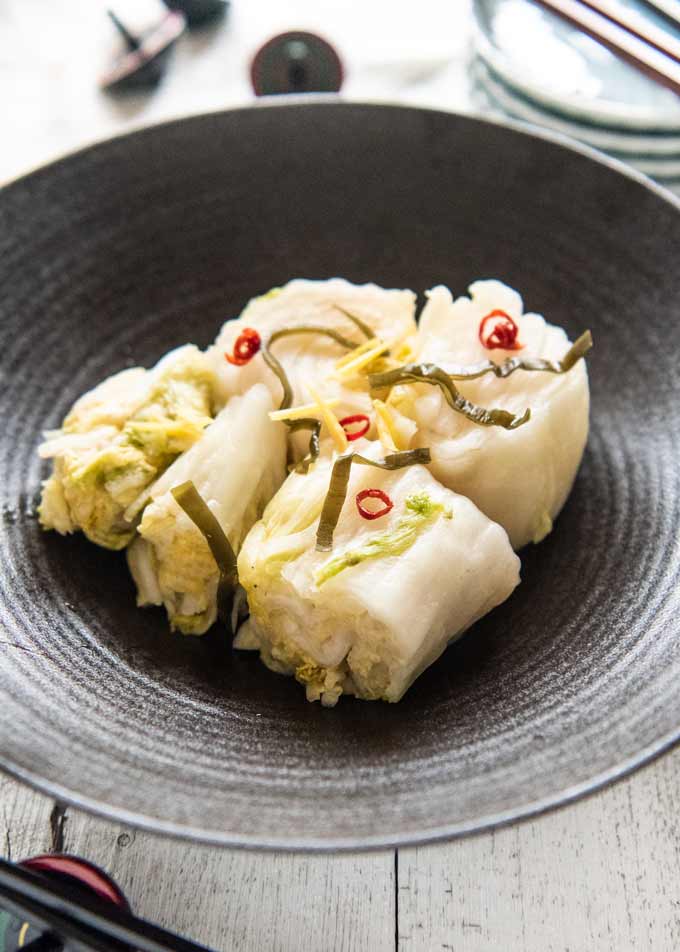
After posting Chinese Cabbage and Apple Salad, I thought some readers might be wondering what to do with the rest of the cabbage, as they are usually sold whole or half. Pickling is a great way of using up a large amount of Chinese/nappa cabbage.
Although they are the same, I called it nappa cabbage instead of Chinese cabbage because the recipe name becomes a bit confusing otherwise. Imagine if the title is ‘Japanese-style Pickled Chinese Cabbage’!
From now on in this post, I will call it Chinese cabbage most of the time because that’s what I am used to calling it. I hope you don’t mind.
What you need to make Pickled Nappa Cabbage
The ingredients below are what you need to pickle Chinese cabbage in the traditional Japanese way. I used half a cabbage but there is no limitation to the amount of pickled cabbage you can make at once. Some households in Japan make a barrelful of pickled cabbage at a time.
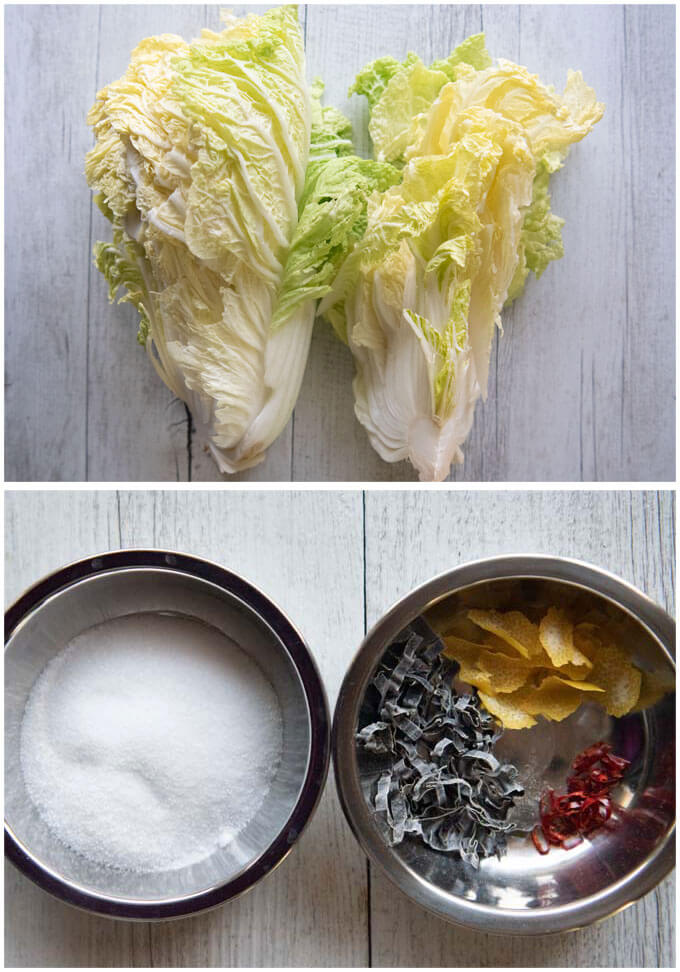
Two Chinese cabbage wedges above are already dried.
- ½ Nappa/Chinese cabbage (also called wombok) – halved vertically to make two quarter wedges.
- Salt – 3% of the weight of the cabbage after semi-drying.
- Konbu strips – cut from a 5cm x 10xm / 2” x 4” konbu sheet
- 1-2 dried chilli – finely sliced.
- Lemon rind pieces from half a lemon.
If your cabbage is very large/fat, you may want to cut the half cabbage into three wedges. There is a good technique to vertically cut a Chinese cabbage for pickling. See the next section.
Some recipes use 4% salt, instead of 3%. I found that it was quite salty with 4% but I am quite sensitive to saltiness. If you like it saltier, you can increase the amount of salt up to 4%.
Other than the pickling ingredients listed above, you need some equipment that you must get ready before pickling.
- A container that can snuggly fit the cabbage wedges, preferably with a lid.
- A plate that can just fit inside of the container
- A weight that is twice as heavy as the weight of the cabbage and a weight that is as heavy as the weight of the cabbage.
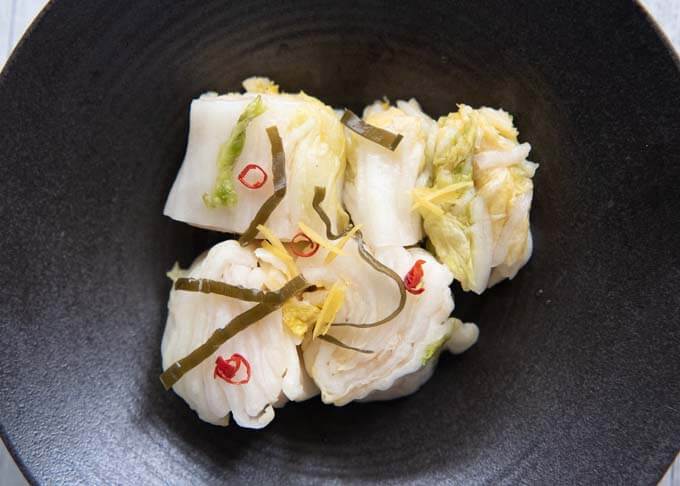
How to Cut the Cabbage vertically for pickling
A whole Chinese cabbage is quite large so you might sometimes buy a half cabbage or even a quarter of a cabbage wrapped in cling wrap. If you did, you probably noticed that pieces of soft leaves along the cut edge fall off the stalk.
This is understandable because the soft part of the Chinese cabbage leaves stretch wider than the width of the stalks. When the cabbage is cut vertically, the edge of the leaves gets cut off the stalks.
When you pickle Chinese cabbage wedges like today’s recipe, you don’t want to end up with lots of soft leaf pieces detached from the stalks. To pickle Chinese cabbage, you need to sprinkle salt between the stalks and in doing so, the loose leaves become nuisance.
Here is how to avoid it:
- Starting from the stem-end of the whole cabbage, halve it vertically but cut it only half-way where the white stalks start thinning.
- Using both your hands, push your thumbs into the cavity at the stem-end and place the 4 fingers on each side of the cabbage.
- Pull the cabbage outward to tear it apart.
- You might need a bit of muscle to start tearing until the tear reaches to the soft part of the cabbage leaves.
- Then continue to separate the two halves gently. The soft leaves should come with the stalks intact.

You can apply the same technique to quarter it as well. You can see all the leaves kept their original shape in the photo above. I cut the half cabbage into three instead of halving it as this cabbage was very large.
How to make it?
Other than needing time to pickle, the actual method of making pickled cabbage is quite simple.
- Semi-dry nappa/Chinese cabbage wedges.
- Pickle the cabbage in a container, topped with a heavy weight.
- Leave it for 3 days in a dark cool place.
- Reduce the weight to half and leave for another 3 days.
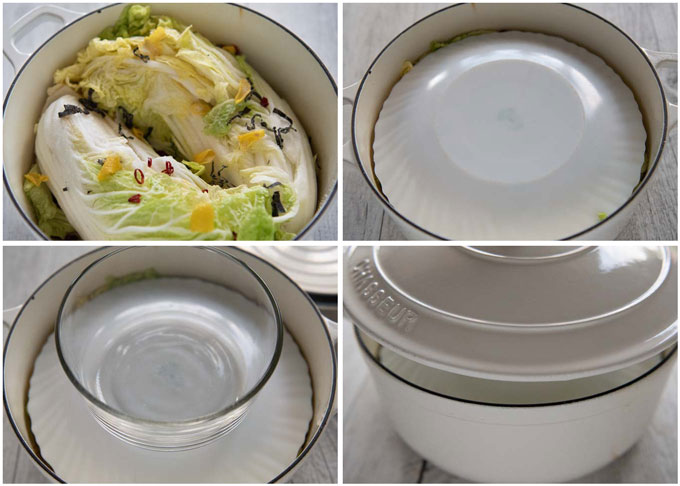
I only dry quartered cabbage for ½ day in the sun, by placing it on a sheet of baking paper. If not sunny, you need to dry it for 5-6 hours.
While pickling, you don’t need to turn the cabbage over because by the 3rd day, the water within the cabbage comes out and the cabbage wedges get submerged in the water that is mixed with the pickling ingredients, i.e. pickling liquid.
Keep the cabbage out of sunlight and in a cool/cold place while pickling. If your house is hot, you need to keep it in the fridge.
After 6 days of pickling, transfer the cabbage wedges with the pickling liquid to a zip lock bag or an air-tight container and store in the fridge.
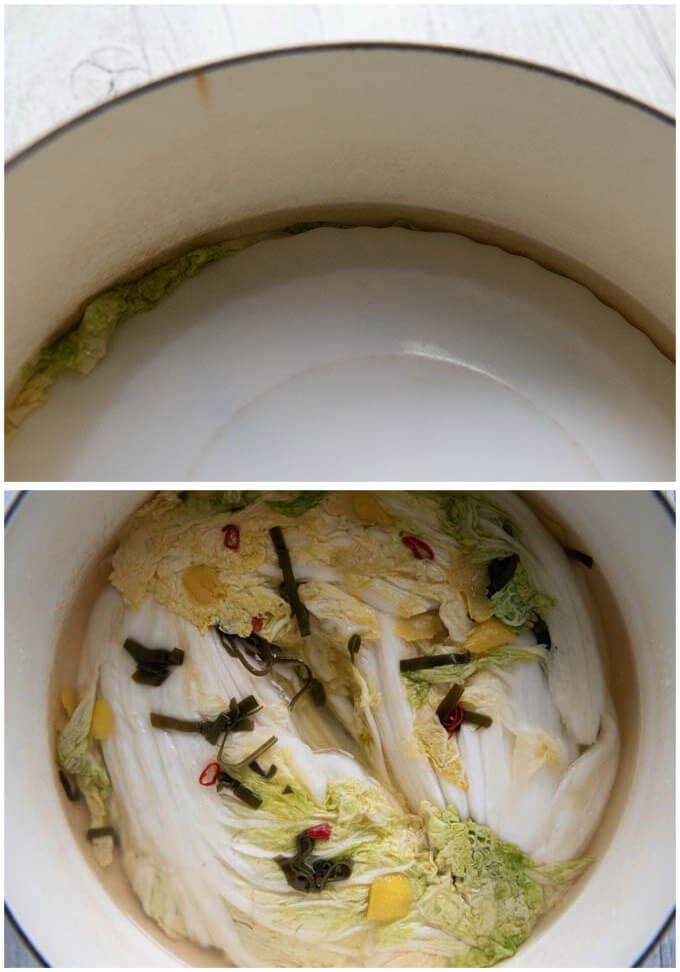
Serving Pickled Cabbage
You can start eating the pickled cabbage after the first 3 days of pickling, but the best time to eat the pickled cabbage starts from the end of pickling. It will be great for a week or so. After that the pickled cabbage starts getting sour, but you can still eat it. Some people enjoy the sour version better.
There are a couple of different ways of serving the pickled cabbage – cut it into large chunks (per my recipe) or cut into thin strips. I usually serve it in chunks, especially while the pickled cabbage is at its best.
You need to cut the pickled cabbage into about 4cm / 1½” long pieces to serve. But before doing that, lightly rinse the cabbage.
When rinsing the cabbage, you can remove the konbu and other pickling ingredients if you want but I leave them natural, except for the lemon rind pieces. I julienne lemon rind and scatter it on the top of the pickled cabbage to decorate.
There are no rules as to how to place each bunch of pickled cabbage on a plate or in a bowl. In my photo, I placed some horizontally, some vertically. If I remember correctly, my mother and grandmother placed them vertically so that people could see every layer of the cabbage pieces at a glance.
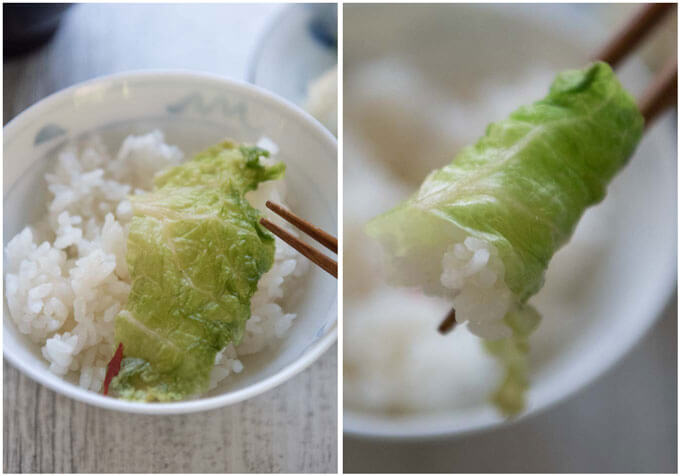
When I was a child, I loved the soft leaves much more than the stem parts of the pickled Chinese cabbage. I used to fight over them with my siblings because nothing was more delicious than rice wrapped in a sheet of soft pickled cabbage leaf like the photo above.
Pickled Nappa Cabbage is one of the popular pickled dishes that regularly appears on the dining table at home as well as at ryokan (Japanese-style hotel). It is also a side dish often included in a breakfast set menu at Japanese-style cafeteria.
Yumiko![]()
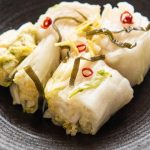
This is a serious Japanese method for Pickled Nappa Cabbage, but it is easy to follow. Nappa cabbage is the same as Chinese cabbage. Pickled with just salt, konbu, chilli and lemon rind (optional), it is quite easy to make. But it takes 7 days before you can enjoy one of the most typical Japanese pickled dishes.
- ½ Chinese cabbage (mine was 1.2kg / 2.6lb after semi-drying, note 1)
- 36g / 1.3oz salt (note 2)
- 1-2 dried chilli finely sliced (note 3)
- 1 sheet konbu (5cm x 10xm / 2” x 4”) cut to thin strips
- ½ lemon zest pieces (optional)
- 1 non-metal deep and large container (with a lid if possible, note 4)
- 1 plate that is little bit smaller than the opening of the container
- 1 weight that is twice as heavy as the weight of the cabbage (Weight 1, note 5)
- 1 weight that weighs the same as the cabbage (Weight 2, note 5)
-
Halve the Chinese cabbage vertically (note 6) to have two quarters of cabbage wedges.
-
Place the cabbage wedges on paper (baking paper, newspaper, etc) and dry them in the sun for ½ day (note 7).
-
Weigh the cabbage and calculate the quantity of salt required (note 2).
-
Lightly rinse the Chinese cabbage and pat dry outside.
-
Sprinkle some salt on the bottom of the container. Sprinkle 1/3 of the konbu, chilli and lemon rind.
-
Take a wedge of the Chinese cabbage and sprinkle some salt between the stalks, particularly the bottom part where the white stalks are thick. I do this in the container.
-
Sprinkle the salt around the cabbage and rub, then place the cabbage in the container/pot, cut side down.
-
Repeat for the other cabbage wedge and place next to the first wedge in the opposite direction so that the tip of the cabbage wedge meets the stem-end of the first cabbage (note 8).
-
Scatter the remaining ingredients, including salt over the cabbage.
-
Place the plate over the cabbage and press down.
-
Place Weight 1 on the plate and place the lid on or cover with cling wrap. Leave it in the dark cool/cold place for 3 days.
-
You should see water has risen in the container (note 9). Replace the weight with Weight 2, place the lid on or cover with cling wrap and leave for further 3 days.
-
Transfer the pickled cabbage with the liquid to a smaller container or a zip lock bag and keep in the fridge until required.
-
Lightly rinse the cabbage (note 10) and squeeze the water out.
-
Place the cabbage on the cutting board, trim the end of the stem off and cut it into 4cm wide pieces.
-
Squeeze residual water out of each bunch of cabbage pieces and transfer to the serving plate/bowl. Scatter with the julienned lemon rind if you want.
1. I forgot to weigh the cabbage before drying but it does not matter really, as the weight after semi-drying is the key and the amount of the most important pickling ingredient, salt, is worked out from the semi-dried cabbage.
2. You will need 3% of the weight of the Chinese cabbage after semi-drying.
3. If you prefer less spicy, use 1 stalk.
4. You need to be able to place the two Chinese cabbage wedges snuggly at the bottom of the container. I used an enamelled cast iron pot.
Metal container without coating should be avoided because the salty and sour liquid is not good for it.
5. Anything is fine as long as they can be placed steadily on the plate to press on the cabbage.
I needed 2.4kg / 5.3lb (Weight 1) and 1.2kg / 2.6lb (Weight 2) of the weights. The lid of my cast iron pot was 1.9kg / 4.2lb. So I used a glass bowl that weighed 500g / 1.1lb in addition to that. For 1.2kg / 2.6lb weight, I filled water in the glass bowl with a lid.
6. If your cabbage is very thick, you may cut it into 3 wedges vertically.
See the steps in the section, HOW TO CUT THE CABBAGE VERTICALLY FOR PICKLING, to avoid soft leaves chopped off and detached from the stem.
7. If cloudy and no sunshine, leave for 5-6 hours.
8. It is important to fill the area with the cabbage without leaving spaces.
9. From the 2nd day, you should see water starts coming up. If it does not, increase the weight or add a small amount of water to the container.
10. I did not remove the konbu and chilli pieces that came with the pickled cabbages. I removed the lemon rind pieces but julienned some to scatter them on the top.
Meal Ideas
A typical Japanese meal consists of a main dish, a couple of side dishes, a soup and rice. I try to come up with a combination of dishes with a variety of flavours, colours, textures and make-ahead dishes.
Pickled Nappa Cabbage often appears in a set menu at Japanese-style cafeteria. So, I picked dishes to make up a set menu today.
Nothing beats grilled fish as a main, which is accompanied by a side dish and a small amount of pickles. There is always a miso soup with a bowl of rice. I picked Tonjiru to supplement more vegetables but you can have any miso soup, or even clear soup.
- Main: Japanese Salmon (Slated Salmon) – make ahead for marinating
- Side dish 1: Hijiki Seaweed Salad (Hijiki no Nimono) – make ahead
- Side dish 2: Japanese-style Pickled Nappa Cabbage – today’s recipe, make ahead
- Soup: Tonjiru (Pork and Vegetable Miso Soup) – can be made ahead but better to be freshly made
- Rice: Cooked Rice
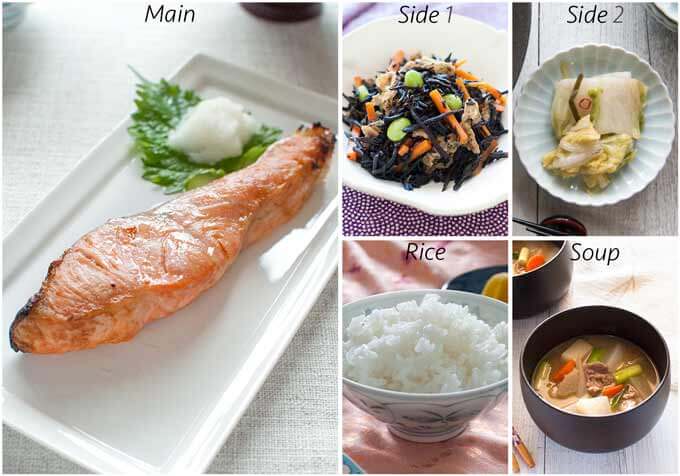
This makes me remember my mother. She used to make it, but i did not pay attention to how she did it, so I have not made any in years. Mom had some contraption that she would put the cabbage in, and the lid had a built-in plate that she could screw down to put pressure on it, and not have to use a bowl and weight any more. Gonna have to try this!
Hi Tina, I know the tool your mom was using. I used to use a plastic tub which came with the screw lid to press down the vegetables too. You may be able to find it at Japanese grocery stores. There are some sold online. Search on ‘tsukemono pickle press’. The round one is the best.
Awesome. I am getting hungry reading this. Thank you for sharing.
Hi Pamela, this pickled nappa cabbage is a handy dish to have in the fridge.